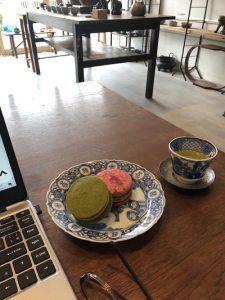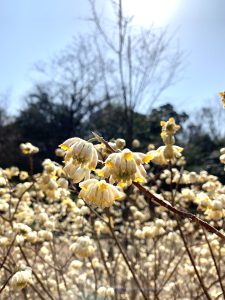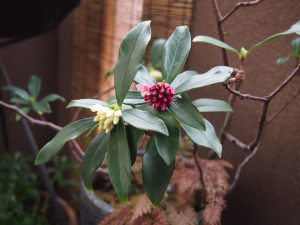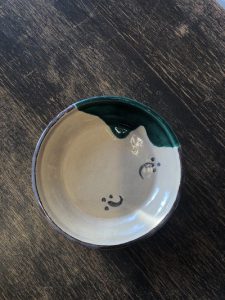そういえば最近、土筆(つくし)をみていませんいませんね。(愛知県名古屋市千種区姫池通 骨董買取いたします 古美術風光舎)
2022.03.20
みなさまこんにちは、スタッフYでございます。

このところの陽気で、桜をはじめモクレンやユキヤナギなどなど花々が街を彩りはじめましたね。いやぁ賑やか。ドライブ好きのわたくしも、このところどこへ行くにもドライブを楽しませていいただいております。次のお休みのドライブ計画を立てることがもっぱら楽しくてしかたありませんね。
そういえば、先日弊店にございます 石渡風古作「幼女」の掛軸をご紹介いた際に、画をくまなく観察しておりましたら幼女の足元に「土筆」があることを発見。弊店のブログやSNSをチェックしてくださっている皆さまはお分かりだったでしょうか。
「土筆」

画の中ではみつけることができましたが、そういえば最後に土筆をみかけたのはいつだったのでしょうか…。
私にも幼少期がございまして当時は河岸の広っぱに行き、夢中になって草をかき分け、土筆を取ったものです。背の伸びた土筆を我先に取ったと自慢したり、袋いっぱいになった土筆を友達と嬉しそうに持ち帰った夕暮れを思い出しました。トンと見なくなった土筆、見かけなくなって久しいですね。
そんな河岸で摘み取った土筆は、はかまといわれる部分を丁寧にとり、炒めて卵とじにしたり、煮びたしにしたりとまあ質素なおばんさいになるのですが、なにせ自ら摘み取った土筆を小さな子供がはかまを取って、美味しくいただきましたので、今でも味やその時の記憶が大変色濃く残っております。いやぁ、懐かしい。
それにしても土筆、よくよく観察いたしますとちょっと変わったフォルム。まさに「土から出てきた筆」でして、独特であります。
ご存じの通り、春になると地面から顔を出すスギナという植物の胞子茎(胞子穂)でありまして、トクサ科トクサ属のシダ植物。春先3~4月頃、まだグリーンが少ない野原や河原の斜面などに顔を出します。スギナとつくし(土筆)は地下茎で繋がっていて、スギナは光合成をする役割、つくし(土筆)は胞子を飛ばす役割と、それぞれの役割を分担し担当。
土筆が顔を出すころ、スギナも勢いよく伸び始めますので、土筆を探すのもスギナをかき分けながらのたたかいとなるのですが、そういえば子供の背丈ですとけっこう足をとられながらのたたかいだったような記憶が。
先ほども述べましたとおり、つくし(土筆)は筆を逆さに地面に挿したような形状でして、ベージュに近い色に、節には焼け焦げたような茶色の袴(ハカマ)がくっついております。春に地下茎から伸びてきて、胞子を飛ばすと枯れていきます。
そうそう、当時摘み取っていたのはまだ傘の開いていないしゅっとした土筆でしたので、まだ胞子が飛ぶ前のもののような記憶が。そして、スギナはつくし(土筆)より少し遅れて出てきて、夏が終わる頃まで旺盛に生育し繁茂するのですが、その後秋には枯れ、翌春また土筆から顔をだし、遅れてスギナが勢いよく成長していくというルーティーン。
そんなスギナはシダ植物ですのでもちろん花は咲きませんが、つくし(土筆)はスギナの花のような存在。ただただ胞子を飛ばすだけのお役目ですので、花のように虫たちを惹きつける美しい花弁も香りも蜜も必要ありませんので、なるほどあのような必要最低限の装備と見た目になるのでしょうね。なるほど独特なフォルムになるはずだ。
そんな地味で独特なフォルムであるにもかかわらず「つくし(土筆)」は春の季語とされているのは、皆さま周知の事実。
桜のような派手な花弁も持ち合わせもせずに、あの地味で独特なフォルムでもって「春」と認証されるのですから、なんとも印象に残る個性派でありますね。
このところなかなかあうことができない「土筆」。
そんなことをつぶやいておりましたら、ものすごく土筆の卵とじが食べたくなってきましたね。
今度あえたのなら、はかまをとり、卵とじを作りながら、昔の思い出を全部引っ張り出して美味しくいただきたいものです。
それでは、ごきげんよう。
Hello everyone, this is Staff Y.
With the cheerfulness of these days, flowers such as cherry blossoms, magnolias, and spiraea thunbergii have begun to color the city. No, it’s lively. I, who loves driving, have been enjoying driving everywhere I go. It’s just fun to make a drive plan for your next vacation.
By the way, when I introduced the hanging scroll of Fuko the other day, I found that there was a “horsetail” at the feet of the little girl when I was observing all over the picture, but I checked our blog and SNS. Did you understand all of you?
“horsetail”.
It’s in the picture, but by the way, when did you last see the horsetail?
I also had a childhood, and at that time I went to the wide area of the riverbank, and I was absorbed in cutting through the grass and taking a horsetail. I was proud to have taken the tall horsetail, and remembered the evening when I happily brought back the full bag of horsetail with my friends. It’s been a long time since I haven’t seen a horsetail that I haven’t seen.
The horsetail picked on such a riverbank is a simple horsetail that is made by carefully removing the part called the horsetail, damaging it to make it into an egg, or making it boiled. Because of this, the taste and memories of that time still remain very strong. Well, it’s nostalgic.
If you look closely at such a horsetail, it has a slightly unusual form. It is truly a “brush that came out of the soil” and is unique.
As you know, it is a spore stem (spore spike) of a plant called horsetail that emerges from the ground in spring, and is a fern plant of the horsetail family Horsetail genus. From March to April in early spring, I will appear on the slopes of fields and rivers where there are still few greens. Horsetail and Tsukushi (horsetail) are connected by a rhizome, and horsetail has a role of photosynthesis, and horsetail (horsetail) has a role of flying spores.
By the time the horsetail comes out, the horsetail also begins to grow vigorously, so searching for the horsetail is also a struggle while squeezing the horsetail, but by the way, it was a battle while the height of the child was quite high. I have such a memory.
As I mentioned earlier, the horsetail (horsetail) is shaped like an inverted brush inserted into the ground, with a color close to beige, and a burnt brown hakama attached to the knots. increase. It grows from the rhizome in spring and withers when it shoots spores.
Oh yeah, it seems that what I was picking at that time was a horsetail with an open umbrella. The horsetail comes out a little later than Tsukushi (horsetail), and grows vigorously until the end of summer and thrives, but then withers in the fall, and the next spring, the horsetail comes out of the clay brush again, and the horsetail comes out later. A routine that grows vigorously.
Of course, horsetail does not bloom because it is a fern plant, but Tsukushi (horsetail) is like a horsetail flower. However, since it only serves to fly spores, it does not require beautiful petals, scents, or nectar that attract insects like flowers, so it looks like that kind of minimum equipment. .. It should have a unique form.
Of course, it is a well-known fact that “horsetail” is a spring season word.
It is certified as “spring” with its sober and unique form without having flashy petals like cherry blossoms, so the impression is a strong and memorable individuality.
“Horsetail” that I can’t quite meet these days.
If you have a chance this time, I would like you to take a hakama, make an egg binding, and bring out all the memories of the past to make it delicious.
Well then, good luck.
**********************
三月にはいりました。
暖かくなり、また新しい年度に向けてお片付けをはじめられた方もいらっしゃるのではないでしょうか。
生活様式の変化とともに、大切なお品を整理されている方も多いことと思われます。
ここ古美術風光舎では、古美術品や骨董品の他にも絵画や宝石、趣味のお品など様々なジャンルのものを買受しております。
お片付けをされていて、こういうものでもいいのかしらと迷われているものでも、どうぞお気軽にご相談下さいませ。
古美術風光舎は、出張買取も強化しております。
愛知県内はもちろん、岐阜県・三重県その他の県へも出張いたします。
どんなにご近所の方でもお伺いできますので、まずはお電話お待ちしております。
愛知県名古屋市千種区・骨董 買取
『古美術 風光舎 名古屋店』
TEL 052(734)8444
10:00-17:00 OPEN


























